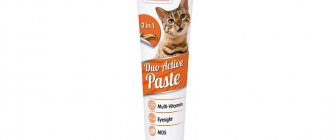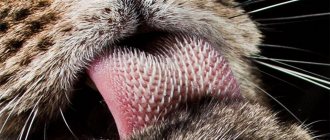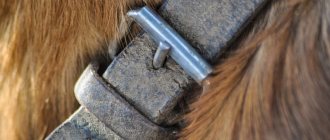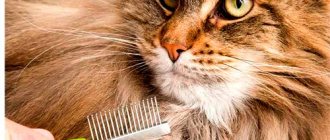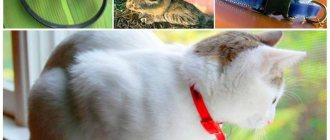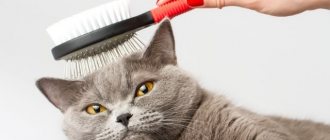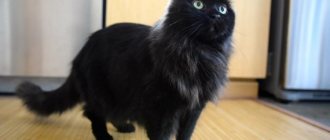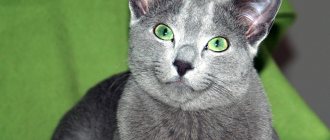Cats are clean animals. They hunt by ambush and need to be careful not to let their scent give them away. Instinct forces you to monitor the cleanliness of the coats of animals that live in an apartment or on a personal plot. A rough tongue replaces a shower and a comb. After hygiene procedures, hairs remain on it, which the animal swallows. Not all of the wool is excreted along with the digested food; some is retained in the stomach and clumps into lumps - bezoars. They can fill a large part of the stomach, disrupting the normal digestive process. Bezoars provoke vomiting, constipation, and loss of appetite. The cat feels that his stomach is full after eating a little food, and does not receive enough nutrients. Sometimes hairballs cause intestinal obstruction. Only emergency surgery can save a pet's life.
Regular brushing, especially during the shedding period, will reduce the amount of hair ingested, but some of it will still end up in the cat's stomach. To speed up the removal of hair from your cat's stomach and prevent the formation of lumps, offer her malt paste.
What does malt paste consist of and how does it work?
Malt paste for cats is a food additive that promotes the rapid removal of hair from the body and prevents the union of hairs. It got its name because of its main component – malt (in English “malt”). Sprouted grains are rich in fiber and vitamins. Additionally, pastes are enriched with mineral complexes, vegetable oils, brewer's yeast, prebiotics and probiotics that stimulate digestive activity, adsorbent substances, natural and synthetic ingredients that improve the taste and smell of additives.
The fiber and vegetable oils contained in cat hair removal pastes coat individual hairs and lumps, which makes them easier to remove. They stimulate intestinal peristalsis, activate the movement of digested food through the digestive system, and with it the swallowed wool. It is quickly eliminated naturally, without provoking vomiting.
What are trichobezoars
This is the scientific term for hairballs that lodge directly in the stomach. Their formation due to regular washing and regurgitation is a natural process for representatives of the cat family. In most cases, the formation of hairballs and their removal does not cause noticeable problems, but in long-haired cats negative consequences are much more common.
Due to the narrow lumen of the esophagus, trichobezoars take on a cylindrical shape. Inexperienced owners are often scared when their cat begins to vomit due to their breeding, but there is no need to panic.
In its structure, a cat's tongue resembles a grater - its rough surface combs the fur when washing, and collects hairs. Some of them are spat out by the pet, others go down the esophagus, lingering in the stomach or going into the intestines, from where they are released with feces.
Note! If your pet has short hair, this does not prevent the formation of lumps and fur in the stomach. The process is slower and the risk of complications is reduced, but the likelihood of trichobezoars remains, so owners should be aware of the symptoms of this phenomenon and methods for eliminating them.
Normally this occurs without complications, but if the formation in the stomach becomes too large, it cannot leave the body. This often happens in the case of:
- intensive licking during molting;
- metabolic disorders;
- hormonal imbalances;
- stress;
- lack of vitamins;
- as a result of impaired motility of the gastrointestinal tract.
The animals themselves have already developed a mechanism to eliminate the problem - eating grass. Wheatgrass helps to regurgitate accumulated hair, however, this is only possible if the cat is outside. The likelihood of developing trichobezoars is especially high in Maine Coons, Persian cats and other breeds with long hair.
Symptoms of Hairballs in Cats
The problem of hairballs forming in the stomach can even occur in kittens. Normally, every pet cleans its digestive tract by regurgitating fur from one to six times a month.
If this process does not occur naturally, the following symptoms may appear:
- constipation, too hard stool with pieces of six in the stool;
- regular vomiting with hair coming out;
- heat;
- the appearance of blood or mucus in the vomit;
- cough;
- refusal to eat due to a feeling of pressure in the intestines and stomach;
- copious amounts of saliva;
- swollen belly - the cat does not allow you to touch it because of the pain.
If your pet has several of the symptoms on the list and you clearly see fur in the stool or vomit, be sure to visit a veterinarian. Usually, to relieve symptoms, malt pastes are prescribed, which facilitate hair removal in cats with long hair and pets prone to the formation of hairballs.
Benefits of eating malt paste
Malt paste for hair removal:
- maintains health by ensuring the prevention of digestive system disorders and intestinal obstruction;
- contains vitamins and microelements that strengthen the immune system;
- normalizes the functioning of the stomach, intestines, kidneys, liver, eliminates constipation;
- contains minerals, vitamins, fatty acids that improve the condition of the coat, it becomes shiny and falls out less between seasonal molts;
- has a pleasant taste - animals perceive it as a delicacy and willingly eat a portion;
- convenient for use - following the instructions, it is easy to calculate and give your pet a portion of the nutritional supplement;
- compatible with natural food, dry food and canned food, most medications, but if the animal is undergoing treatment, check with your veterinarian whether he needs malt paste for cats;
- does not cause allergic reactions or addiction.
The best pastes for hair removal
The pet products market offers malt pastes from both domestic and foreign manufacturers.
For our mini-rating, we selected the following products:
- Gimpet Malt-Soft Paste Extra (Germany);
- Beaphar “Duo Malt Pasta” (Netherlands);
- Kittymalt Hairball Remedy Paste, 8 in 1 Excel;
- Beaphar “Malt Paste” (Netherlands);
- Paste “Cliny” (Russia);
- Sanal Malt Paste (Netherlands);
- Ecoprom “Stop Problem” (Russia).
Gimpet Malt-Soft Paste Extra
The paste for removing hairballs is of high German quality. This is the best malt paste according to reviews from cat owners. The active ingredient, malt extract, softens bezoars and facilitates their excretion through the intestines.
The paste is made on the basis of natural vegetable oils and fibers. Malt-Soft improves the process of food movement, promotes the natural removal of hairballs and undigested food residues.
- Plus: contains no sugar.
- Disadvantage: high cost.
Price: tube 200 gr. – from 730 to 800 rub.
Beaphar “Duo Malt Pasta”
Beafar two-layer paste consists of malt paste and conditioner paste. It has a dual effect – it prevents the formation of hairballs and normalizes the cat’s intestinal function.
Ingredients: malt extract, milk and dairy products, yeast, oils and fats. BIO-MOS in the conditioner layer formulation has an absorbent effect - it removes pathogenic bacteria from the pet’s body. Caramel is added to improve the taste of the product. Contains Omega-3 and Omega-6.
- Plus: improves wool quality.
- Cons: Not all animals like the taste.
Price: tube 100 gr. – from 600 to 650 rubles.
Kittymalt Hairball Remedy Paste, 8 in 1 Excel
An effective malt paste for long-haired and short-haired animals that live without walking outside. Designed for adult animals and kittens.
Ingredients: vegetable oil, malt, lecithin, salmon oil, mono- and diglycerides of fatty acids, Omega-3, Omega-6, Omega-9, glycerin, vitamin E. Has a pronounced fishy aroma and taste.
- Plus: gently removes hair naturally.
- Cons: Not all animals like the smell.
Price: tube 120 gr. – from 280 to 340 rub.
Beaphar “Malt Paste”
The medicinal paste removes ingested fur from the animal’s stomach. Prevents vomiting, relieves loss of appetite, constipation and intestinal obstruction.
Application is especially effective during seasonal molting. It has an oil-fat base, contains Omega-3 and Omega-6, and yeast. The active ingredient is malt extract. Recommended for improving appetite and normalizing the gastrointestinal tract.
- Pro: Suitable for all ages.
- Disadvantage: high cost.
Price: tube 100 gr. – from 610 to 640 rub.
Pasta “Cliny”
The domestically produced therapeutic and prophylactic hair removal paste effectively prevents constipation in animals. The active ingredients of the paste envelop hairballs in the cat’s stomach and intestines, facilitating their removal.
Ingredients: malt concentrate, corn oil, wheat bran, milk powder, lactose, soy protein, silver benzoate. Silver ions have a pronounced disinfectant effect. Prevents gagging, regulates appetite.
- Plus: it has an attractive taste for cats.
- Disadvantage: it is packaged in small tubes.
Price: tube 45 g. – from 330 to 380 rub.
Sanal Malt Paste
Malt paste with a meaty taste is eaten with pleasure by cats. The drug lubricates swallowed fluff, hairs and hairballs, does not allow them to gather in a large lump, and facilitates defecation. The active ingredient is malt concentrate.
Has a pronounced preventive effect. Normalizes intestinal microflora, improves appetite.
- Plus: contains vitamin E.
- Minus: when cooled, it is difficult to squeeze out of the tube.
Price: tube 20 g. – from 220 to 280 rub.
Ecoprom “Stop Problem”
The domestic product removes hairballs from the gastrointestinal tract and prevents their formation.
In the recipe: malt extract, wheat bran, corn oil, milk powder, soy protein. Sorbic acid is used as a preservative.
Recommended for use during seasonal shedding of cats and ferrets.
- Plus: a cheap analogue of “Cliny” paste.
- Cons: Smaller packaging.
Price: 60 ml tube. – from 213 to 249 rubles.
When should you take malt paste to remove hair from cats?
You can observe how cats, walking freely around the garden, eat grass that provokes vomiting, and cleanse their stomachs of swallowed hairs. Pets living in apartments are deprived of this opportunity. Grown from seeds purchased at veterinary stores, the herb is rich in vitamins, but it does not stimulate hair loss; only malt paste for cats .
But animals that have the opportunity to walk freely on the street and eat grass also need to be given additional medications to remove hair from cats. Suitable plants do not grow everywhere, are not available in winter, and are often not effective enough to prevent hairballs from forming in the stomach.
Their appearance is indicated by the following symptoms:
- decreased appetite;
- constipation;
- vomit;
- weight loss;
- lethargy or restlessness.
To avoid the development of intestinal obstruction and exhaustion, take your cat to the veterinarian.
Analogs of hair removal pastes
Malt paste against hairballs for cats is an effective and convenient remedy. However, some cats refuse pasty treats, preferring other forms of release.
Treats
A pasty substance similar to marshmallow is produced in the form of compressed pads or rings. Pets really like these products because, in addition to the classic ingredients, they contain catnip.
Tablets and vitamins
Special nutritional supplements help cope with trichobezoars. They are called phytomins and are produced from extracts of medicinal plants, minerals, lecithin and taurine. Phytomines are produced in the form of tablets that are convenient to give to your pet during meals.
The veterinarian prescribes the tablets, determining the dosage and duration of their use. The effect of phytomins is not quick - the hair will leave the cat’s body gradually.
In addition, there are special vitamin and mineral supplements designed to gently cleanse the gastrointestinal tract. Pet Naturals of Vermont products, containing plantain extract and healthy fatty acids, are popular among cat owners.
Some dry food manufacturers immediately include phytomins and malt extract in their dry granules. Usually in such cases a mark is placed on the packaging about the hair-removing properties of the food. If the cat eats just such a product, there is no need to give additional malt pastes and analogues.
Will regular grass do the job?
Animals themselves have long developed a mechanism for removing lumps from the stomach and intestines. They eat grass - usually wheatgrass. It can trigger a gag reflex and thereby help regurgitate accumulated hair.
Street animals easily use this, but mustachioed couch potatoes do not have this opportunity. Then pots with sown grass and sprouted sprouts come to the rescue, which are added to the cat’s food.
For short-haired cats, grass is enough, but long-haired cats will need paste in any case. Veterinarians also recommend malt products for animals with sensitive digestion and chronic diseases.
How to give malt paste
Veterinarians recommend giving your cat a hair remover when she first starts shedding. The supplement must be given in a course. Its duration and regimen will be determined by your veterinarian, taking into account the pet’s weight, age, breed, coat length, and health status.
The drug is given every day, squeezing 3 cm of paste out of a tube (for large long-haired cats - 5 cm) for 2-3 weeks or a weekly course with a daily dose of 5-6 cm. If the pet suffers from constipation, there is frequent vomiting, you can increase the dose once to 15 cm.
Maltpaste for cats has a pleasant taste. You can squeeze it into your pet's empty bowl, onto your hand, or directly into your pet's mouth if he refuses to eat.
The drug is given between meals, 1.5-2 hours before feeding. But if the cat is capricious and it is difficult for him to give the supplement separately, mix the paste with the food.
Cliny
Russian analogue from the company, characterized by an affordable price. The active ingredients are malt extract and whole milk powder. Not recommended for use in the presence of gastrointestinal diseases and allergies to cereals.
Ingredients: malt concentrate, refined corn oil, wheat bran, lactose monohydrate, soy protein isolate, whole milk powder, potassium sorbate, silver benzoate, water.
Price:
- small tube – 330 rub. / 30 ml;
- medium tube – 470 rub. / 75 ml;
- large package – 600 rub. / 200 ml.
Sanal
Another drug from the Netherlands. Sanal malt paste has no contraindications for use; it contains ash and vitamin E as additional components.
Ingredients: vegetable products, oils and fats, sugar; supplements per 1 kg: vitamin E 75 mg.
Price: 190 rub. / 20 ml and 550 rub. / 130 ml.
All of the products mentioned effectively eliminate trichobezoars, but before purchasing you should carefully read the instructions for any contraindications.
Advice! The mixture has a thick consistency, so squeezing it out of the tube may be difficult. To avoid this, you can remove the tube from the refrigerator shortly before use and leave it to warm up to room temperature.
Features of the use of malt pastes for cats
The paste for removing hair from a cat’s stomach works within a few hours after administration. Intestinal peristalsis is activated and swallowed hairs are removed from the stomach. You can notice an increase in their number in the animal’s feces. Other changes: improved appetite, coat condition, normalization of the digestive system, appear after some time.
Important! A closed tube of malt paste can be stored at room temperature. But after the first use, it should be stored in the refrigerator at a temperature of 2-8 ° C (fresh vegetable compartment, shelves on the door).
Products for removing hair from a cat's stomach are not addictive. Having completed the course prescribed by the veterinarian, you can refuse them until the next molt. Malt, brewer's yeast, vitamin-mineral complexes and other substances in pastes very rarely cause allergic reactions. They have no side effects, but due to their mild laxative effect and increased appetite, they are not given during exacerbation of chronic diseases of the liver, kidneys, and stomach.
Contraindications and possible side effects
Malt paste is equally suitable for kittens, adult animals and older, weakened individuals. It has no other contraindications, except for serious pathologies of the digestive system and liver problems. Also, paste for cats is not prescribed in case of the formation of a large hairball that causes intestinal obstruction.
The drug has virtually no side effects. But the components present in its composition in rare cases cause allergies. Therefore, when using the wool dissolving paste for the first time, it is recommended to reduce the dose of the drug and look at the animal’s reaction. If the cat becomes restless and begins to itch, then this malt paste is not suitable for him.
How to choose drugs to remove fur from a cat’s stomach?
Pet stores offer a large selection of hair removal products. Pastes from different manufacturers differ in composition, but the active ingredient in all of them is malt extract. Its action complements and enhances vegetable oil: sunflower, corn, olive. The most commonly used is corn. But some manufacturers do not indicate the type of oil.
The composition also includes brewer's yeast, milk and dairy products. Some cats do not tolerate them well, but there are preparations that do not contain dairy products, sugar, or brewer's yeast (important for overweight animals with a tendency to obesity). You can choose products for removing hair from cats with chicken, salmon, cheese, taurine, vitamins A, C, E, and mineral complexes. The composition may contain flavoring additives, flavorings, and dyes.
Reviews from consumers and veterinarians
Albina: “I have a Scottish fold. One day the cat started coughing and vomited a hairball. I called my veterinarian, he recommended purchasing Gimpet or Beafar hair removal medications. The pet store only had Klini, a Russian drug. The taste of the food additive immediately attracted the cat’s attention, and she licked it off my hand. The nausea stopped. Now I give her the paste every morning before breakfast.”
Sergey: “When I took my Persian to the nursery, I was immediately advised to buy hair removal paste for cats. The cat is long-haired and sheds heavily. I purchased the product “8 in 1 Excel” - it does its job perfectly. The cat has regular stools; hairballs are removed into the litter box. There is no vomiting or regurgitation. The cat has an excellent appetite. The wool is in perfect order.”
Arkady, veterinarian: “Malt pastes can hardly be called a medicine. This is a feed additive that can be taken on an ongoing basis without any harm to the pet’s health. The advantage of these drugs is that manufacturers add vitamins and minerals to them. Clients often come to me with the question: “Is it necessary to comb the cat if we give it malt paste?” Of course it is necessary. Scratching and bathing – no one can cancel these mandatory procedures. It is also important to promptly clean the cat’s bedding and habitat from accumulated hair.”
Svetlana Igorevna, veterinarian: “As an alternative to malt paste, I would recommend grass for cats. Some owners give their pets regular Vaseline from the pharmacy, but I still recommend not getting carried away with this, but buying specialized products. Veterinary pharmacies now have a good selection of drugs, both imported and domestically produced. The active ingredients of most of them are identical. You can choose malt paste according to your wallet. There are products with good formulas enhanced with vitamins, amino acids and minerals.”
Video
The dangers of excessive cat licking
Filling the stomach with hair pellets can cause blockage of the intestinal lumen.
However, filling the stomach with hair pellets is fraught with some difficulties:
- internal fullness does not allow the pet to get enough, resulting in exhaustion;
- a large amount of hair inside can cause blockage of the intestinal lumen;
- the remaining hairs behind the fangs gradually grow into the gums, causing inflammation.
The question arises how to protect your pet from the formation of hairballs in the stomach cavity. Unfortunately, a person is powerless against this, but you can help the lumps come out. There are several ways to get this help. First you need to figure out how to understand that a cat needs help.
Main reasons for eating wool as food
Unfortunately, at the moment there are no exact reasons to explain this behavior in animals. Some of the assumptions and guesses include various psychological disorders or a lack of nutrients and vitamins in the pet’s daily diet. Many owners note that after severe stressful situations, their cat changed its preferences and tastes in food. If you begin to notice how your beloved cat often swallows hair while washing and cannot get rid of it on its own, and also shows a special interest in woolen products as food, then you should contact a specialist as soon as possible. The veterinary pharmacy and pet store Gomeovet will provide advice, help identify the reasons for this behavior and make your pet’s life easier.

